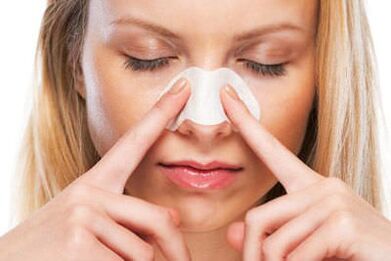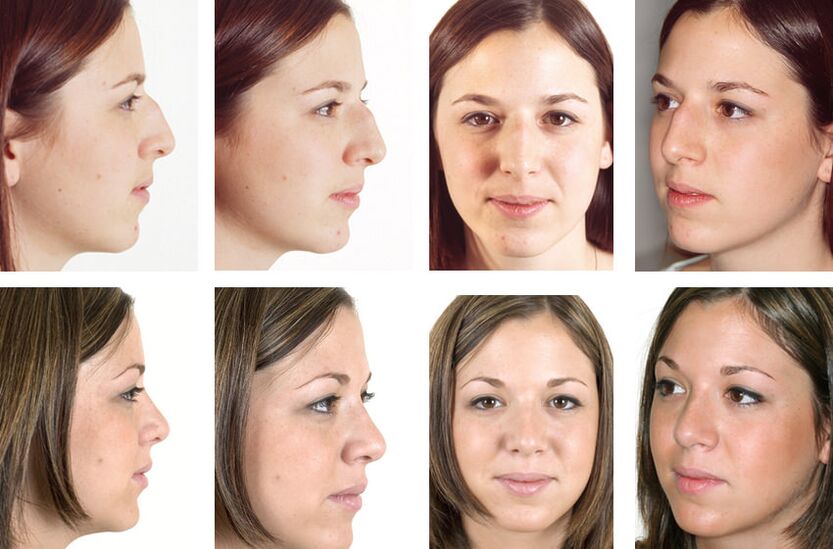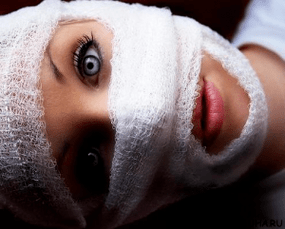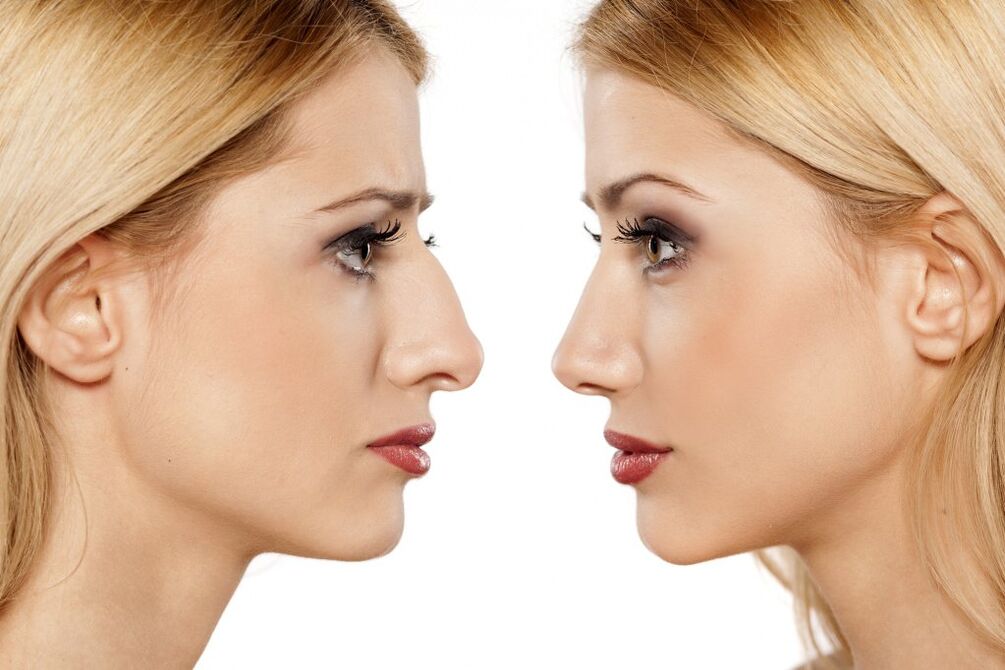Rinoplasty is a special surgical operation, which is done to correct congenital or acquired nasal defects, as well as an increase in the number of lost nose.
Rhinoplasty surgery lies in the fact that the surgeon changes the nasal parameters with the invasion of the nasal bone frame.
The main task of such an operation is to restore the proper nose shape to a person who is violated before birth, due to illness or through the nasal injury.

Rhinoplasty type
Today, the world uses a type of nose rinoplasty:
- septoplasty;
- closed rhinoplasty;
- open rhinoplasty;
- rhinoplasty on secondary behavior;
- Rhinoplasty without surgery;
- rhinoplasty while using filler;
- Rhinoplasty uses special supplements;
- Rinoplasty uses aptos yarn.
Septoplasty
Septoplasty is a surgical intervention that prescribes the task of eliminating defects in the nasal septum - cartilage and bone displacement, which interferes with normal functioning and aesthetic nose type.
Hints for septoplasty for humans:
- Nasal congestion persists for no apparent reason;
- snoring;
- nasal development defects, or nasal partitions;
- Nasal bleeding persists or periodically;
- the presence of chronic sinusitis;
- general deformation of the nose;
- The result of a nasal injury that prevents normal respiratory function.
Contraindications to septoplasty:
- presence of diabetes;
- too many nasal septum deviations;
- The presence of diseases of the cardiovascular system.
Rhinoplasty is closed
Rhinoplasty is closed as an operation is more accessible to patients than open rhinoplasty. This procedure is performed by endonasal access to the nose, that is, the wound is made directly in the nose.
This operation has several advantages for patients, but it is very difficult for surgeons, as it is easier for any surgeon to undergo surgery in a well -accessed operating field. Therefore, in closed rhinoplastic there are more opportunities for medical errors, as a result of complications or other problems in the patient may occur.
Advantages of closed rhinoplasty:
- The operating period is much lower than the open rhinoplasty;
- Nasal tissue is not cut on the surface of the nose and a smaller piece of size;
- less likely to have the appearance of scars;
- Smaller edema after surgery;
- The results of the operation can be seen a few days earlier.

Indications for closed rhinoplasty:
- aesthetics (curves, ugly forms of nose, nasal deformation, etc. );
- Medicine (nasal injury, respiratory tightness due to the wrong nose structure).
Contraindications for this type of operation:
- the presence of mental illness in patients;
- the lack of the patient's final results;
- presence of diseases where rhinoplasty is contraindicated;
- Implementation of patients some of the unsuccessful rhinoplastic patients, which are very deformed by the soft tissue of the nose.
Because closed rhinoplasty is a rather complicated operation, after his behavior, the patient may have the following complications:
- inflammation of the nasal tissue;
- scarring (rarely);
- the formation of pigmentation on the skin, which can last forever;
- bleeding;
- nasal bleeding;
- swelling or hematoma around the nose;
- Incorrect nose form, which requires secondary operation.
Open rhinoplasty
Open rhinoplasty, unlike closed, is done with small pieces, with a diameter of 4 - 5 mm. Thanks to the almost invisible section, the nasal skin can be fully raised and then the surgeon will be easier to work with the open nose framework, as it will see in front of the entire external structure of this organ, unlike closed rhinoplasty. This greatly reduces the chance of surgical errors.
In addition, open rhinoplasty is recommended for the main operation, as it is more accurate to eliminate all existing nasal defects, unlike closed rhinoplasty, which cannot guarantee the same results.
Rinoplasty about secondary behavior
Secondary rhinoplasty is performed if the main is unsuccessful and needs to correct the complications. It can be carried out both open and closed.
Rinoplasty without surgery
Rinoplasty without surgery is performed in only 4-7 % of patients who can perform without surgery. With its help, only a small nasal defect can be corrected. More serious problems in the structure and appearance of the nose only require complete rhinoplasty operation.
Rinoplasty while using the filler
This procedure is performed if the patient wants to eliminate only small nasal defects. For example, these can be a variety of small weaknesses, weaknesses, nasal development, symmetrical inability, and more. In this case, doctors use a special filler introduced into the nasal tissue and they correct the problem.
The advantage of this method is that nasal recovery after it is easier, and the procedure itself is not as painful as regular surgical intervention.
The disadvantage of rhinoplasty using the filler is a change in the structure of the nasal tissue and the possibility of "migration" on the nasal surface of the drug.
Rhinoplasty using special supplements
To perform such a procedure, surgeons use special drugs based on hormones introduced to a defective nasal zone.
The advantage of such rhinoplasty is that the patient is not subject to surgical intervention. But such a huge disadvantage of rhinoplasty is by calculating improper dose of the drug and its introduction to the wrong area of the nose, the patient may have a variety of complications and deterioration of defects.

Rhinoplasty using a thread
This procedure is performed using a thread where the doctor pulls the nose and nose wings. These threads stand through special punctures on the nose and, like that, pull their nose.
Rinoplasty uses yarns not often used by surgeons, as they have several drawbacks:
- After the procedure, there is a great probability of scarring;
- contour and ugly nose type in "eyes";
- The high probability of rest in the thread, as the nose is very portable in its structure, which provides to be unreliable this procedure.
The advantages and disadvantages of rhinoplasty
Plus of Rhinoplasty:
- satisfaction with his appearance after surgery;
- complete removal of any defects in successful procedures;
- Increase breathing in pre -operative disorders.
Deficiency rhinoplasty:
- the possibility of obtaining infection;
- loss of nasal sensitivity;
- bleeding;
- unsuccessful operations, complications;
- The deterioration of the nasal appearance and dissatisfaction with the end result.
Indications and contraindications
If a person has a congenital nose defect, but he or she can do rhinoplasty with an adult start. In general, ages 18 to 40 are considered the most appropriate age for this procedure, when the body is formed and one makes a balanced decision.
Hints for rhinoplasty:
- presence of bumps in the nose;
- congenital nasal defects;
- nasal defects obtained by injury;
- a complete violation or impairment of breathing with his nose;
- The nose is too wide;
- The nose is too long;
- Nose in the form of a tangled saddle;
- Nose additions such as hooks;
- The nose is too thick;
- Too sharp nose.
Contraindications to rhinoplasty:
- Human minority (if the injury is obtained as a child, then the procedure may be performed in a premature line);
- Age after the fourth anniversary (since this time, one has the risk of all types of complications and worsen the wound healing process);
- presence of diabetes mellitus;
- all types of kidney or liver disease;
- problems with the patient's blood clotting;
- serious heart disease and blood vessels;
- acute viral disease;
- the presence of oncological diseases;
- presence of mental disorders;
- If there is no nasal defect and rhinoplasty is not only required.
Preparation for rhinoplasty
Since rhinoplasty is a full operation, for some time before that, the patient should do the following:
- Have a full examination for the presence of cardiovascular disease.
- Pass the examination and take advice from therapists, neuropathologists, laura, anesthetics, surgeons who will perform operations, etc.
- To discuss with the surgeon all the possibilities of surgery and determine the future forms of the nose, wide, etc. -should also discuss the type of anesthesia with anesthesia, which will be used during operation.
- Pass all the necessary tests.

Running operations - level
Rinoplasty is carried out at this stage:
- Patients are given anesthesia;
- Additional anesthesia is performed;
- After that, the surgeon made a slice on the nose shell and started directly to his work (such surgical intervention could be closed and open type);
- Surgeons adjust all nasal defects, correct distortions, bumps, and others, depending on the patient's specific problems;
- If necessary, he can replace the lost car in the nose from another zone or imitation of implant implant;
- Upon completion of the operation, the surgeon sews his nose and wore a fixture.
Depending on the level of complexity and course of procedure, rhinoplasty operation can last from 50 minutes to 2 hours. It should also be mentioned that the nose after surgery may be subject to free changes in the form of improvement or deterioration.
All of this depends on the patient, compliance with medical recommendations and directly, the outcome of the operation itself, which will be seen only after 6-8 months.
A period of recovery
After rhinoplasty, in the nose and around its territory, as vaccines, swelling and hematoma are formed, which usually goes within two weeks. After surgery, special setting is used for the nose of the patient, which must be used within ten days. Tampons will also be inserted into the nose, which will prevent bleeding, so for some time the patient is unable to breathe.
The results of the operation can be evaluated in six months, and the final results are one year. The delay in the wound after surgery depends on the person individually and the state of his or her life. If complications are observed after surgery, the healing line can increase significantly.
After rhinoplasty, it is advisable to visit his surgeon to perform a nose examination after rhinoplasty.
Suggestions before and after surgery
Before surgery, the patient follows:
- abandon all bad habits (alcohol, fatty foods, etc. -more);
- A few days before surgery, drugs and products were prohibited, which caused a decrease in blood clotting in the body.
After surgery, the patient must comply with the following requirements:
- In the first month after rhinoplasty, one cannot be involved in sports (gymnastics, walking, etc. -more);
- It is not desirable to swim;
- Do not eat too hungry or hot food, to prevent bleeding;
- Wash carefully, without touching the nose and zone around it;
- prevent sharp changes in facial expressions;
- Wear unnecessary clothes on the head.

The possibility of complications after surgery
After rhinoplasty or during the procedure itself, the following complications may occur:
- Allergies to anesthesia.
- Many nasal bleeding.
- Nasal zone edema (within the first week after the procedure), which can interfere with normal nasal breathing.
- Swelling in the face (in the eyes, cheeks and other parts of the face).
- The occurrence of hematoma in the face.
- Reduces nasal skin sensitivity or absolute loss for a moment.
- The risk of infection.
- Large scars can form, to eliminate other required operations.
- Breathing is difficult after surgery (depending on the type of operation and procedure). Which will be carried out with nose cartilage.
- The absence of a lack of odor or partial loss.
- Skin stretching or loss of flexibility (occurs with excess cutting cartilage in the nose).
- Narrow tissue.
- Formation of spots -age spots or manifestations of blood vessels on the skin.
- The result of a deadly anaphylactic shock.
- Patient dissatisfaction with the final results of the procedure.
- The course of procedure is unsuccessful through the surgeon's error.
Result
The first result of the operation will be visible after 10-14 days. But the patient can see the end result only after 8-10 months, when all edema and bruises will go and the cloth will "lie down" on the new nose.
It is often the case that relatives and friends do not see significant changes in the appearance of the patient after surgery. Because hematoma and swelling will submerge the whole result. In this case, the patient does not need to immediately walk to the repeated rhinoplasty, but it will only be expected when the face comes into normal form and then evaluates the end result.
Also, it should be shown that rhinoplasty does not have a genetic effect and will not be sent by a clan for children, as some patients can consider. This operation only enhances one's appearance.




















